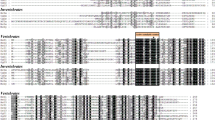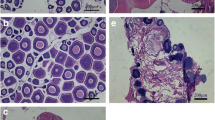Abstract
The conversion of an erythropoietic system from larval to adult type in anuran amphibia may possibly come about through cell replacement. The hormonal regulation of apoptosis of larval-type precursor cells and adult-type cell proliferation has yet to be examined in detail. In amphibians, corticoids synergize T3 action during metamorphosis. In the present study, examination was made of the process of larval-to-adult conversion in the liver erythropoietic site of Xenopus laevis, with special attention to how these metamorphic hormones, T3 and corticoid, regulate programmed cell death specific for larval erythroblasts and the proliferation of adult cells. Immunohistochemical analysis of liver sections indicates that the number of larval erythroblasts decreased to less than 50% at the early climax stage (stages 59–60) of metamorphosis. Overall liver morphology greatly changed subsequent to the climax stage from the three-lobe to the two-lobe shape. The addition of T3 (10-8 M) to premetamorphic tadpoles induced considerable liver morphological change and a 50% decrease in larval-type erythroblasts. These erythroblast decreases seem to take place through the apoptotic process, since double-staining experiments with in situ DNA nick-end labeling (TUNEL) and hemoglobin immunostaining revealed that DNA breakage of nuclei, a well-known feature of apoptosis, occured specifically in larval erythroblasts during prometamorphosis. Hydrocortisone (HC), which modulates T3 action during metamorphosis, was found not to be a factor in larval cell decrease. But adult erythroblasts increased by 8 times as much through the action of T3 and 32 times as much by the action of T3 plus HC, indicating the important action of T3–HC synergism. It thus follows that the erythropoietic system is converted during metamorphosis effectively by two distinct hormonal mechanisms, T3–HC synergism on adult erythroblast proliferation and T3-mediated programmed death of larval precursor cells.
Similar content being viewed by others
Author information
Authors and Affiliations
Additional information
Accepted: 14 January 1999
Rights and permissions
About this article
Cite this article
Nishikawa, A., Hayashi, H. T3-hydrocortisone synergism on adult-type erythroblast proliferation and T3-mediated apoptosis of larval-type erythroblasts during erythropoietic conversion in Xenopus laevis . Histochemistry 111, 325–334 (1999). https://doi.org/10.1007/s004180050364
Issue Date:
DOI: https://doi.org/10.1007/s004180050364




